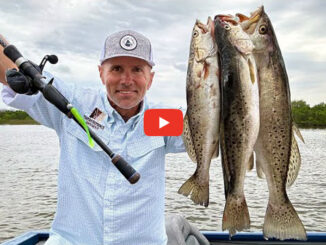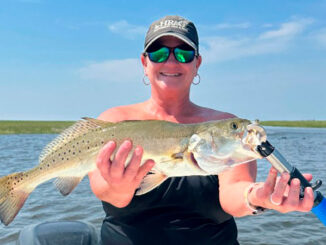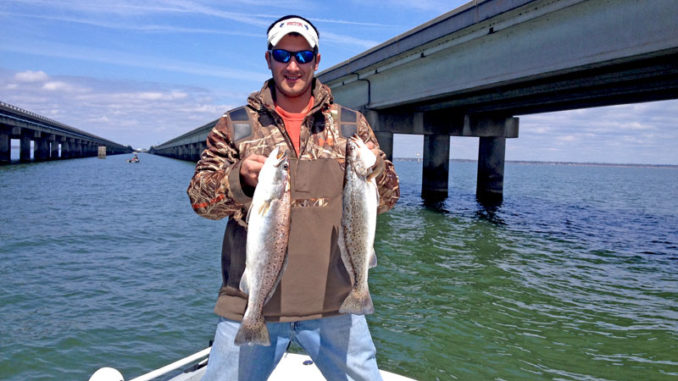
These tips for December fishing should put more trout in your cooler and provide plenty of Christmas cheer.
December arrives in south Louisiana with a hint of winter but still carrying the remains of fall. The white shrimp have mostly moved out of inshore waters, and many baitfish species, such as mullet, will see their breeding stock moving out as the month ages.
Water temperatures are dropping from the balmy 70s of November into the 60s and even the 50s when the winds of cold fronts descend on the marsh. December is a month of extremes, as the fronts can push air temperatures 25 degrees in either direction. Fortunately, there is still enough warmth coming up from the Gulf of Mexico that winter temperatures cannot settle in.
Two big changes that December brings to our inshore environment are falling water temperatures and a reduction of shrimp as the primary food source for predators. The change in water temperature is not just absolute, but also the deviation from mean. This is important to consider, because the deviations that drive water temperature up into the high 60s or down into the high 50s will move speckled trout from one habitat to another. This means that one week, they are stacked up at the Great Wall of Chalmette, and the next week, they are gone with the warm winds that blew through.
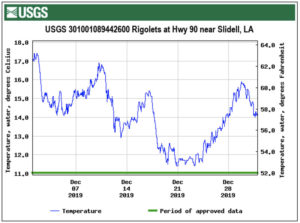
The fabulous 50s
I prefer the water temperature to be consistently in the high 50s. This is a perfect temperature to keep fish in deep holes and channels or around deep-water bridges. Consistent water temperature means I will find trout from weekend to weekend in the same general areas. By contrast, the warm fronts that roll through in December can send me searching far and wide for these rascals.
As a general rule, speckled trout go deep on water temperature extremes. Their metabolism is directly linked to water temperature, and the extremes of our range can be deadly. To avoid them, hot or cold, trout seek deep water. They may also be found in deep water in mild temperatures, but as a general rule, they stay shallow when the water temperature is roughly in the 60- to 80-degree range. They seek deeper water in temperatures outside that range.
The deeper water where I look for them in December is 6 to 25 feet, but mostly I will be targeting 10 to 15 feet of water. Their desire to feed when water is moving remains constant, whether they’re in shallow or deep water, so fishing the tide conditions in December is important.
Deep-water getaways
I spend a lot of December fishing in and around the Mississippi River Gulf Outlet channel, aka MRGO. I’ll fish everywhere from its intersection with the ICW to south of the rock dam near Hopedale. There is more than enough fishing in the channel to eat up all of December. Of course, speckled trout are found all over the coast, from the Lake Pontchartrain bridges to the lakes and bayous of the marsh. However, most anglers find success in areas where deep bayous or channels provide a nearby escape for the trout when strong cold fronts descend.
December is also a great time to find some of the larger speckled trout along our coast. The cool temperatures and abundance of bait have brought them in from nearshore waters. In December, areas like Pontchartrain and the MRGO offer them food, optimal feeding conditions and protection. Large numbers of baitfish are hanging around, either there to overwinter — such as sheepshead minnows — or migrating out like mature mullet and croakers.
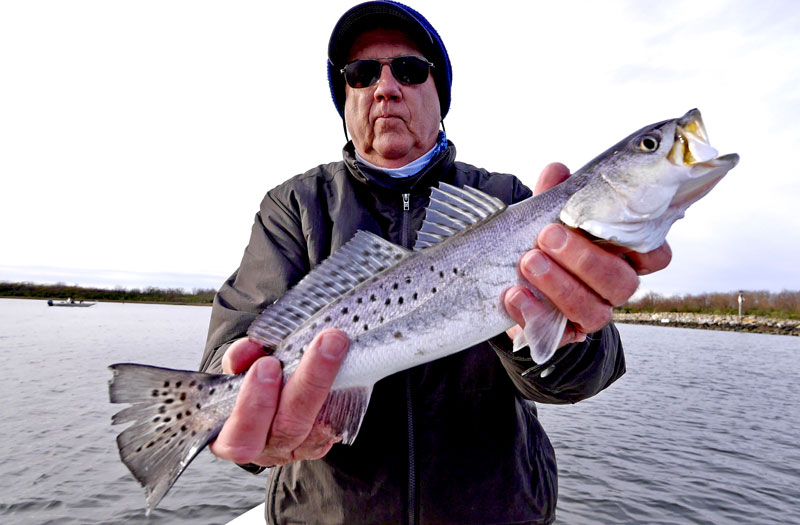
Short days, good days
One of the other features I love about December is the timing of daylight. The winter solstice, the shortest day of the year, is Dec. 21. That means I do not need to hit the water as early nor drive as far from the launch. In December, trout often bite later in the day, once the sunlight penetrates and warms the water. This makes for a shorter fishing day, but the catching can be excellent from mid-morning to late afternoon.
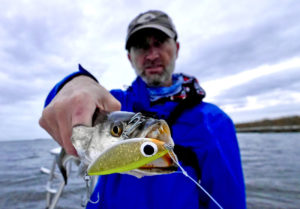
When I target December trout in deeper water, I am fishing the bottom, which may be the channel proper or the rocks on the MRGO shoreline. Either way, I most often find the trout respond most favorably to slower presentations. I use baits that perform well when worked more slowly, such as soft plastics on jigs or sinking twitchbaits. I have had December days where jigging the bait produced few bites, whereas a steady, slow drag along the bottom drove the trout mad.
When I fish the rocky shorelines of the MRGO, I look for areas that have rocks extending into deeper water. Some of the best areas have rocks in 10 to 12 feet of water. These rocks, which are uncommon, can be found with sonar or by snagging them with your lures. When I find these rocks submerged in deep water, I set a waypoint on my chart so I can find them later.
I lose a lot of lures to rocks in December, but that is one of the necessary sacrifices to effectively fishing them. Trout seem to hold tight to rocks, whether they are submerged or on the shorelines. On many days, my jig had to hit the rocks or come very close to get a strike. You can cut down on the losses by anticipating the collision and pull up as soon as you feel the impact. The impact could also be a fish taking the bait as it nears the rocks, in which case you have set the hook with your response.
The fat boy rules
One of my favorite lures to fish in December is the iconic Paul Brown Fat Boy, now a member of the MirrOlure family, but dating back to a time when Paul Brown was making lures and selling them from his garage. It may appear to be a simple lure, even unsophisticated, but the advantage it brings is the capacity to give an angler the freedom to deliver strike-inducing action in slow motion. I fish other twitch baits from MirrOlure and Rapala, and each lure has its own strengths, but the Fat Boy is unparalleled in its ability to shake and shimmy while sinking slowly to the bottom. This provides both the slow fishability I am looking for in December and an adequate amount of shake to convince a big trout it is seeing an injured baitfish ready to be gobbled up.
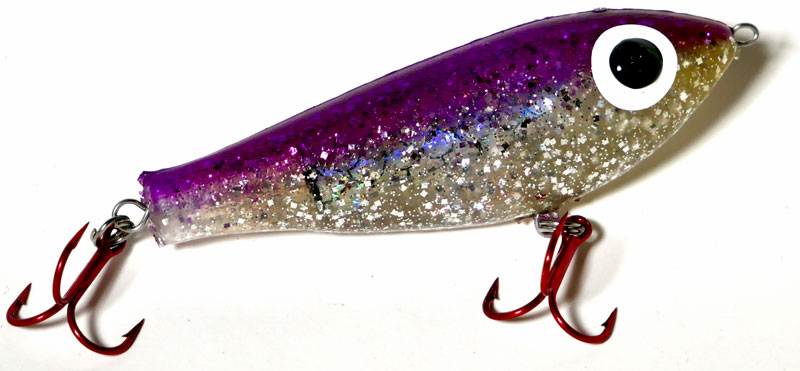
I know that the Fat Boy is fished in various ways, but I prefer to bring it up with a few sweeps and let it fall back to the bottom. It is also a large lure at 3½ inches and 7/8-ounce and thus has the promise of a hardy meal for a big trout. I primarily fish a Fat Boy along rock shorelines in 6 to 10 feet of water. I don’t find it to be as effective in deeper or fast-flowing water. In a strong current, its big body gets carried too rapidly and never reaches the depths I need.
When I am fishing fast water, such as on a strong outgoing tide on the south side of the MRGO dam, my lure choices are a swimbait and jig. I primarily fish the original Matrix Shad swimbaits, which are baits with smaller profiles. This is a good choice for the optimal conditions at the dam, because the small lure profile on a 3/8-ounce lead head falls through the current more quickly to reach the trout that are waiting just off the bottom.
The dam has a steep gradient, so my target depth of 15 feet is only around 30 feet from the shoreline. Therefore, the swimbait must fall fast enough to reach the bottom at a point where the trout are staged for feeding. You might suggest using a 1/2-ounce leadhead to get it down fast; however, I find that with the heavier weight, the lure is not carried enough by the current and simply digs into the rocky bottom.
The trick to hitting the jackpot on every cast is to float the swimbait down the gradient without burying it in the rocks or lifting it over the heads of the trout. I don’t jig the lure any more than is necessary to keep it out of the rocks. It is not necessary to add more action to the lure than what is being imparted to the lure by the current.

